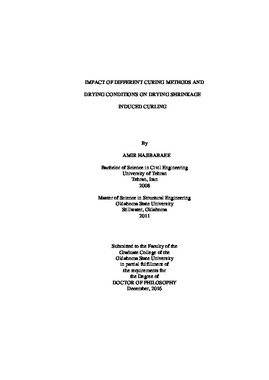| dc.contributor.advisor | Ley, Tyler | |
| dc.contributor.author | Hajibabaee, Amir | |
| dc.date.accessioned | 2018-06-25T13:38:22Z | |
| dc.date.available | 2018-06-25T13:38:22Z | |
| dc.date.issued | 2016-12 | |
| dc.identifier.uri | https://hdl.handle.net/11244/300242 | |
| dc.description.abstract | Prolonged wet curing is thought by many to provide only improvements in concrete performance. Also, because of the large surface to volume ratio of volume change sensitive structures such as slabs on grade, differential moisture loss can cause unwanted deflections, reduction in ride quality, and cracking. This work has shown that there is a potential increase in the amount of curling of these structures that are wet cured and then subject to 1-D drying in severe drying conditions. Experiments on paste beams with different water-to-cementitious ratios and cured for different durations with wet and sealed curing methods as well as alternative tests on concrete beams with different curing lengths suggested that the extended wet curing causes a pore structure refinement resulting in greater saturation and consequently greater shrinkage. A simplified 1-D, drying diffusion and shrinkage model was able to adequately predict experimentally measured peak curling deflections as well as the entire curling history after further adjustments to input parameters and confirmed the effect of saturation on curling. Also, the ability of this analytical model to capture the mechanistic sources of wet curing on peak deflections was evaluated by comparing its predictions to those acquired via a fully nonlinear diffusion model. It was shown the overall deflection predictions by the approximate linearized model were in greater agreement with the measured data than with the full, nonlinear solution. | |
| dc.description.abstract | Curing compounds are used to retain moisture which promotes hydration to develop a tight microstructure. This work provided a quantitative comparison between different curing compounds, wet, sealed, and no curing not made in previous studies and showed that adequate amounts of curing compounds are a useful curing method for members sensitive to differential drying such as concrete pavements in severe drying conditions. However, it was shown in less severe drying conditions that the curling strains caused by drying were minimal since the drying rate was less significant. So, if the concrete pavements are to be used in a moist environment, the type of curing that is used on pavements will have very little impact on their curling deformations. | |
| dc.format | application/pdf | |
| dc.language | en_US | |
| dc.rights | Copyright is held by the author who has granted the Oklahoma State University Library the non-exclusive right to share this material in its institutional repository. Contact Digital Library Services at lib-dls@okstate.edu or 405-744-9161 for the permission policy on the use, reproduction or distribution of this material. | |
| dc.title | Impact of different curing methods and drying conditions on drying shrinkage induced curling | |
| dc.contributor.committeeMember | Russell, Bruce | |
| dc.contributor.committeeMember | Hartell, Julie Ann | |
| dc.contributor.committeeMember | Clark, Peter | |
| osu.filename | Hajibabaee_okstate_0664D_14933.pdf | |
| osu.accesstype | Open Access | |
| dc.type.genre | Dissertation | |
| dc.type.material | Text | |
| thesis.degree.discipline | Civil Engineering | |
| thesis.degree.grantor | Oklahoma State University | |
